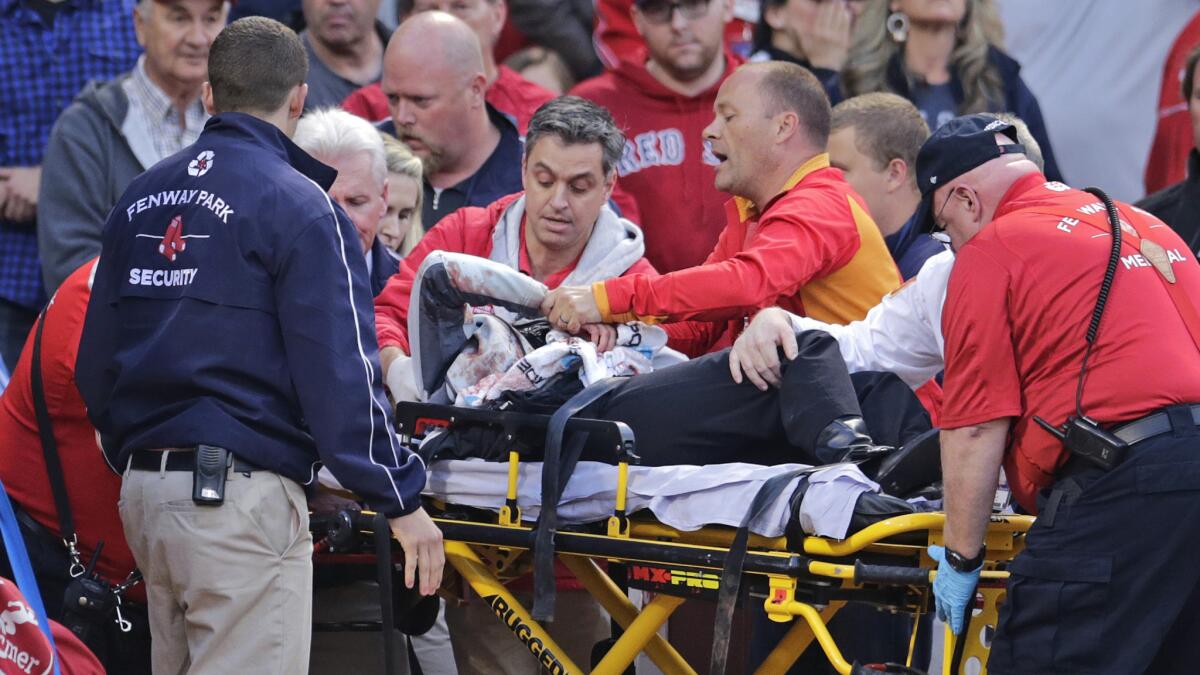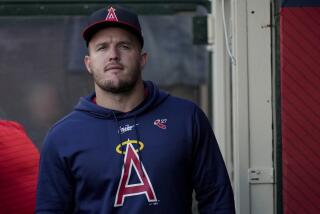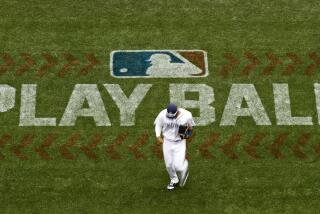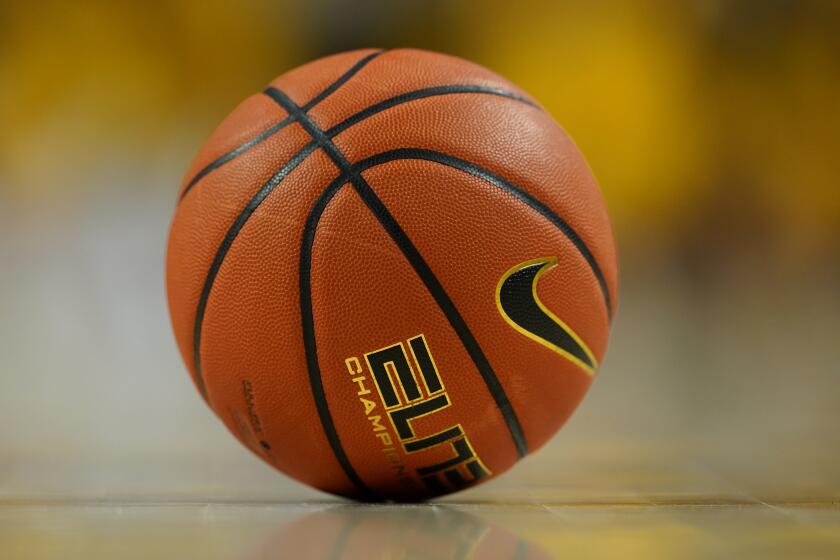MLB needs to protect fans from injury at ballparks

Boston Red Sox fan Tonya Carpenter is taken away on a stretcher after getting hit in the head with a broken bat during a game against the Oakland Athletics at Fenway Park on June 5.
- Share via
The pain has not gone away, seven years later. Neither has the metal inside her body. Surgeons needed that metal to put her jaw back together, after a wayward fragment of a broken bat slammed against the left side of her face.
Susan Rhodes has made what progress she can since that awful night at Dodger Stadium. After that horrifying scene at Boston’s Fenway Park on Friday night — a woman injured by a broken bat, put on a stretcher and rushed to a hospital, where she was in serious condition Saturday — it is past time for baseball to make all the progress it can on keeping fans as safe as possible.
It is past time for an industry that takes in $9 billion a year to buy a few more nets.
The league mandates protective netting behind home plate. If netting had been extended to the end of each dugout, where plenty of line drives and broken bats land, neither Rhodes nor the woman at Fenway Park would have been injured.
In 2008, the year Rhodes was injured and broken bats became an epidemic, baseball identified the core concern as the rise of maple bats — three times more prone to shattering than the traditional ash bats — and imposed design standards intended to minimize the risk of broken bats.
Since then, the number of bats breaking into multiple pieces has dropped by half, MLB spokesman Mike Teevan said Saturday. Based on the 2008 numbers, that would mean about 750 bats would snap into pieces this season. They would not all fly into the stands, of course, but why would MLB oppose additional netting that might save a fan from serious injury or death?
In Japan, that netting is mandated. In 2008, Commissioner Bud Selig said he would not order additional netting because he did not consider it a “practical solution” and preferred to focus on what he called “the root cause” of the broken bats. Within the industry, there is some concern that more nets could mean less interaction between fans and players, and that some fans might be disgruntled with the aesthetics.
Rob Manfred, who replaced Selig as commissioner this year, is expected to review whether additional netting might be in order, according to a person familiar with his thinking but not authorized to discuss it. The only official comment from MLB on Saturday came in a statement offering thoughts and prayers for the woman injured at Fenway Park and gratitude for the first responders.
“Fan safety,” the statement continued, “is our foremost goal.”
Rhodes sued the Dodgers, at the very least to recoup her medical costs.
“She ended up with a whole lot of nothing for her trouble,” her attorney, Alan Ghaleb, said Friday night.
The law stood firmly behind the Dodgers, under the “assumption of risk” doctrine. Translation: We warned you of the risk, on your ticket and at the ballpark, and you decided to take that risk.
“That is absurd,” Ghaleb said. “It could be lethal.”
As baseball embraces technology, its legal position could become increasingly precarious.
Teams want fans to bring smartphones to the ballpark, not just to scan a bar code in place of a ticket, but to enhance the nine innings.
Want to order food that can be delivered to your seat? Look down. Want to take advantage of in-stadium specials on concessions and merchandise? Look down. Want to see all the replays, just like the fans at home? Look down.
That is different from a fan not paying attention. That is the team diverting the attention of the fan.
And that could be an enormous financial liability for baseball, and a political one too. As Manfred well knows, there is no shortage of elected officials who would love to generate a few headlines by summoning him to explain why the league does not take a reasonable consumer safety measure. Think of the children!
Or the league could just go buy a few more nets.
Albert Pujols: Star watch
For the third time in four seasons, Mike Trout could be the Angels’ lone All-Star representative. That appears bitterly ironic, given that this is Albert Pujols’ fourth season with the Angels.
Pujols’ recent surge —six home runs in six games, tied with Trout for fourth in the American League in home runs, through Friday — sparked debate about whether Pujols might represent the Angels in the All-Star game for the first time.
“If that time comes, it comes,” Pujols said. “I’m not going to worry about it. My main focus is on trying to help this club win. That’s it.”
But then Pujols said something quite compelling, given the national perception that he has evolved from one of the greatest hitters in baseball history with the St. Louis Cardinals, with whom he was an All-Star nine times in 11 seasons, into a pretty good but no longer elite hitter with the Angels.
“Look at the numbers over the past four years, just the time I’ve been here,” Pujols said. “They’re right there with anybody else.”
From the start of the 2012 season, there are 17 players with at least 1,000 at-bats whose primary position is first base, through Wednesday. Miguel Cabrera ranks first in basically everything.
Pujols generally fares better in traditional statistics, the so-called “counting stats,” than in modern measures. The primary difference: In St. Louis, after his rookie season, Pujols walked more than he struck out every year. In Anaheim, he has struck out more than he has walked every year.
Of those 17 first basemen, Pujols ranks second in doubles, third in hits and at-bats, fourth in runs, home runs, runs batted in and slugging percentage, sixth in batting average, 11th in on-base percentage and seventh in OPS.
Pujols has gone out of his way to mentor Trout and to praise him as the kind of player that comes along once every 25 years. Trout said he would love to have Pujols join him at the All-Star game.
“I’m pulling for him,” Trout said. “He’s a great teammate and an unbelievable player. He deserves to be there.”
Short hops
Hanley Ramirez made the most sense last off-season as a designated hitter. He can no longer play shortstop in the major leagues, and the value of his bat is tempered by his fragility. But the Boston Red Sox had David Ortiz at DH, so they threw $88 million at Ramirez and sent him to left field at Fenway Park, one of the most challenging outfield spots in the majors. Ramirez leads the team in home runs but, after 45 games in left field, the reviews are in. “Hanley Ramirez looks atrocious in left field,” Peter Abraham of the Boston Globe wrote last week, “worse than even the most pessimistic of projections.” And from Gordon Edes of ESPN Boston: “It can be argued that Hanley Ramirez is the worst left fielder the Boston Red Sox have ever had, taking Manny Ramirez off the hook for eternity.” … The coolest thing about the Oakland Athletics calling up switch-pitcher Pat Venditte? MLB has Rule 5.07(f), titled “Ambidextrous Pitchers.” The rule mandates Venditte announce to each batter whether he will pitch right-handed or left-handed, then demands the batter to decide whether he will hit right-handed or left-handed through the at-bat. Venditte threw two scoreless innings in his major league debut Friday; the A’s are in Anaheim next weekend. … Congratulations to Arn Tellem, the Los Angeles agent who has agreed to become vice chairman of Palace Sports and Entertainment, the parent company of the Detroit Pistons. Tellem would have become the Dodgers’ president three years ago had Steven Cohen and not Mark Walter posted the winning bid to buy the team.
More to Read
Go beyond the scoreboard
Get the latest on L.A.'s teams in the daily Sports Report newsletter.
You may occasionally receive promotional content from the Los Angeles Times.











